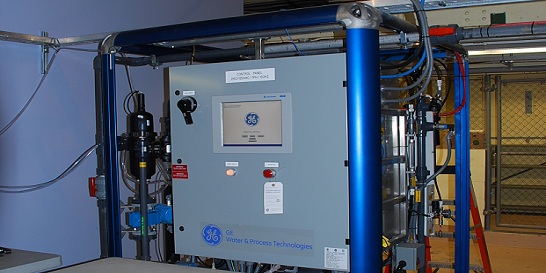
To increase the efficiency of its water treatment process and reduce the use of chemicals, the City of Thunder Bay studied different methods for cleaning filtration membranes at its Bare Point Drinking Water Treatment Plant. After examining membrane foulants (the elements being filtered out of the water) and testing innovative cleaning strategies, the researchers concluded that soaking the membranes while using lower concentrations of sodium hypochlorite (the primary cleaning chemical used to clean membranes) works better and slows membrane deterioration, compared to chemical treatment at higher concentrations. Additional optimizations of the cleaning process included changing the acid used for pH suppression and conducting the two chemical cleaning processes back to back (rather than putting the membranes back in use between the stages of cleaning). The study also included a promising trial of bifunctional electrode technology (using electricity and UV light to remove organic contaminants) which would dramatically reduce the energy requirement for water treatment and help eliminate chemicals from the process. After initially reducing the sodium hypochlorite used in the membrane-cleaning process by 40 per cent, the city eliminated its use completely in October 2014.
Results
| Environmental | Economic | Social |
|
|
|
Challenges
- During the winter, the temperature of water entering the plant is lower than the manufacturer-recommended limit for the membranes.
- Water temperature fluctuations throughout the course of the study resulted in an extreme range of data, creating a need for a follow-up study using temperature-controlled water.
- The plant and Lakehead University are separated geographically, without easy access by bus, adding travel time for student researchers. The university had to put the data into electronic format so that it could be accessed over the Internet.
Lessons learned
- Explore the general correlations between membrane fouling and feed water characteristics such as total organic carbon, particle counts, turbidity, pH and temperature.
- Explore the effect of varying cleaning parameters on membrane life span and operational cost.
- Research options for optimizing the cleaning efficiency of the backwash process.
- Install a temperature control instrument in the pilot plant to eliminate fluctuations in temperature that may affect the properties of membranes and the fouling potential of various organic and inorganic constituents.
- Research the impact of seasonal changes on membrane fouling and performance.
Resources
Partners and Collaborators
Project Contact
Carl Goodwin
Process Engineer, Environment Division
City of Thunder Bay, ON
T. 807-684-3195
Want to explore all GMF-funded projects? Check out the Projects Database for a complete overview of funded projects and get inspired by municipalities of all sizes, across Canada.

